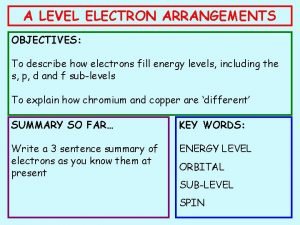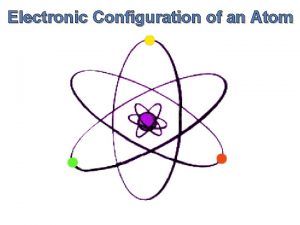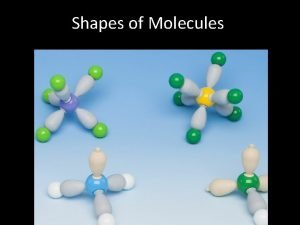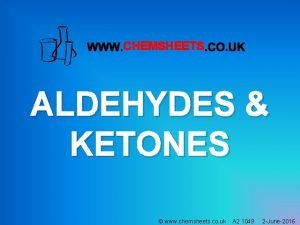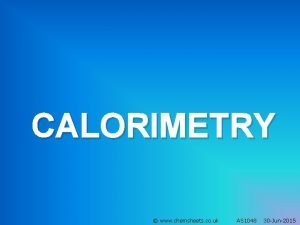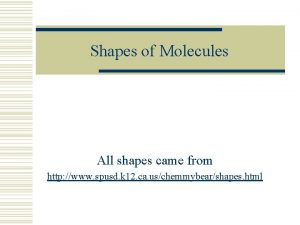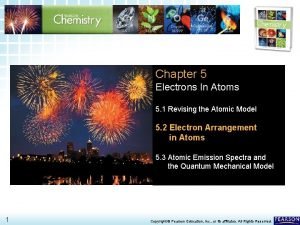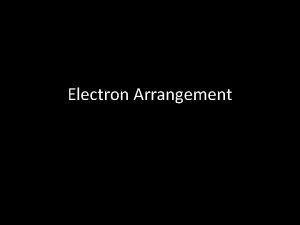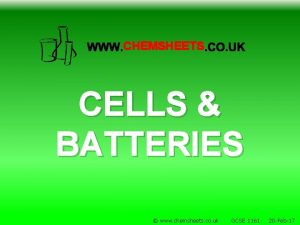CHEMSHEETS ELECTRON ARRANGEMENT www chemsheets co uk AS































- Slides: 31

CHEMSHEETS ELECTRON ARRANGEMENT © www. chemsheets. co. uk AS 1009 3 -Jun-2015

Shells, sub-shells & orbitals • Electrons are arranged in electrons shells (energy levels). • The shells have sub-shells (sub-levels). • Each shell/sub-shell is made up of electron orbitals which can each hold 2 electrons. © www. chemsheets. co. uk AS 1009 3 -Jun-2015

Orbitals • Each sub-level consists of electron orbitals (region of space in which the electron spends most of its time). • Each orbital can hold 2 electrons with opposite spins (one electron spins clockwise and one anticlockwise). • Orbitals are regions of space that electrons are most likely to be in. © www. chemsheets. co. uk AS 1009 3 -Jun-2015

s orbital p orbital © www. chemsheets. co. uk AS 1009 3 -Jun-2015

© www. chemsheets. co. uk AS 006 19 -Feb-12

© www. chemsheets. co. uk AS 1009 3 -Jun-2015

The Orbitron http: //winter. group. shef. ac. uk/orbitron/AOs/1 s/index. html © www. chemsheets. co. uk AS 006 19 -Feb-12

© www. chemsheets. co. uk AS 006 19 -Feb-12

Orbitals Maximum number of electrons in sub-level Sublevel Number of orbitals in sub-level s 1 2 p 3 6 d 5 10 f 7 Shape (no need to learn) Even more complicated! © www. chemsheets. co. uk 14 AS 1009 3 -Jun-2015

other T-shirts are available!!

Aufbau Principle Electrons enter the lowest energy orbital available. © www. chemsheets. co. uk AS 1009 3 -Jun-2015

Hund’s Rule Electrons prefer to occupy orbitals on their own, and only pair up when no empty orbitals of the same energy are available. © www. chemsheets. co. uk AS 1009 3 -Jun-2015

e. g. silicon 14 e- 1 s 2 2 p 6 3 s 2 3 p 2

e. g. calcium 20 e- 1 s 2 2 p 6 3 s 2 3 p 6 4 s 2

Ions • The highest energy electrons are lost when an ion is formed. • Note that 4 s electrons are lost before 3 d (as once 4 s and 3 d are occupied, 4 s moves above 3 d). © www. chemsheets. co. uk AS 1009 3 -Jun-2015

e. g. Ca 2+ 18 e- 1 s 2 2 p 6 3 s 2 3 p 6 © www. chemsheets. co. uk AS 1009 3 -Jun-2015

Cu & Cr • Cu and Cr do not have the expected electron structure. Cr = 1 s 2 2 p 6 3 s 2 3 p 6 4 s 1 3 d 5 NOT 1 s 2 2 p 6 3 s 2 3 p 6 4 s 2 3 d 4 Cu = 1 s 2 2 p 6 3 s 2 3 p 6 4 s 1 3 d 10 NOT 1 s 2 2 p 6 3 s 2 3 p 6 4 s 2 3 d 9 © www. chemsheets. co. uk AS 1009 3 -Jun-2015

Ionisation Energy • Evidence for how the electrons are arranged in atoms comes from ionisation energies. • 1 st ionisation energy = energy required to remove one electron from each atom in a mole of gaseous atoms producing one mole of 1+ gaseous ions. • Note that 2 nd ionisation energy is the energy required to remove the second electron (not both electrons). e. g. 1 st IE of Na: 2 nd IE of Na: Na(g) → Na+(g) + e– Na+ (g) → Na 2+(g) + e © www. chemsheets. co. uk AS 1009 3 -Jun-2015

Ionisation Energy © www. chemsheets. co. uk AS 1009 3 -Jun-2015

1 st ionisation energy (down group) © www. chemsheets. co. uk AS 1009 3 -Jun-2015

1 st ionisation energy (down group) • Atoms get bigger • More shielding • Therefore weaker attraction from nucleus to electron in outer shell © www. chemsheets. co. uk AS 1009 3 -Jun-2015

1 st ionisation energy (across period) © www. chemsheets. co. uk AS 1009 3 -Jun-2015

1 st ionisation energy (across period) General trend • Increased nuclear charge (i. e. more protons) • Atoms get smaller • Therefore stronger attraction from nucleus to electron in outer shell © www. chemsheets. co. uk AS 1009 3 -Jun-2015

1 st ionisation energy (across period) Group 2 → 3 • Electron lost from Group 3 element is from p orbital, while that lost from Group 2 element is from s orbital. • p orbital is higher energy than s orbital, so easier to lose electron. © www. chemsheets. co. uk AS 1009 3 -Jun-2015

1 st ionisation energy (across period) Group 5 → 6 • Group 6 element loses electron from orbital with 2 electrons (p 4) • Group 5 element loses electron from orbital with 1 electrons (p 3) • Extra electron-electron repulsions make it easier to lose electron from p 4 than p 3. © www. chemsheets. co. uk AS 1009 3 -Jun-2015

1 st ionisation energy © www. chemsheets. co. uk AS 1009 3 -Jun-2015

down a group (group 0) 1 st ionisation energy © www. chemsheets. co. uk AS 1009 3 -Jun-2015

down a group (group 1) 1 st ionisation energy © www. chemsheets. co. uk AS 1009 3 -Jun-2015

Across a period 2 period 3 period 4 1 st ionisation energy © www. chemsheets. co. uk AS 1009 3 -Jun-2015

End of period 1 st ionisation energy © www. chemsheets. co. uk AS 1009 3 -Jun-2015

Successive ionisation energies (K) © www. chemsheets. co. uk AS 1009 3 -Jun-2015
 Tetrachloromethane electron arrangement
Tetrachloromethane electron arrangement Orbital p
Orbital p Stable electronic configuration
Stable electronic configuration Chemsheets as 1139
Chemsheets as 1139 Chemsheets
Chemsheets Chemsheets amino acids 2
Chemsheets amino acids 2 Chemsheets shapes of molecules
Chemsheets shapes of molecules Aliphatic amines and aromatic amines
Aliphatic amines and aromatic amines Chemsheets addition polymers 1 answers
Chemsheets addition polymers 1 answers Chemsheets as 1079
Chemsheets as 1079 Propanal + kcn
Propanal + kcn Chemsheets 1017 answers
Chemsheets 1017 answers Chemsheets as 1017
Chemsheets as 1017 Chemsheets periodicity
Chemsheets periodicity Half equations questions and answers
Half equations questions and answers Chemsheets as 1052
Chemsheets as 1052 Chemsheets as 1047 calorimetry 2 answers
Chemsheets as 1047 calorimetry 2 answers Bfcl2 molecular shape
Bfcl2 molecular shape Chemsheets.co.uk
Chemsheets.co.uk Chemsheets polymers
Chemsheets polymers Chemsheets as 1063 answers
Chemsheets as 1063 answers Iof4- shape
Iof4- shape Chemsheets as 1036
Chemsheets as 1036 A level chemistry shapes of molecules
A level chemistry shapes of molecules Structure of flower class 12
Structure of flower class 12 Classification arrangement
Classification arrangement Triangular flower arrangement
Triangular flower arrangement Leaf mosaic arrangement
Leaf mosaic arrangement Topical pattern of arrangement
Topical pattern of arrangement Is consistent orderly or pleasing arrangement of parts
Is consistent orderly or pleasing arrangement of parts Chapter 5 arrangement of electrons
Chapter 5 arrangement of electrons Atiquette
Atiquette

